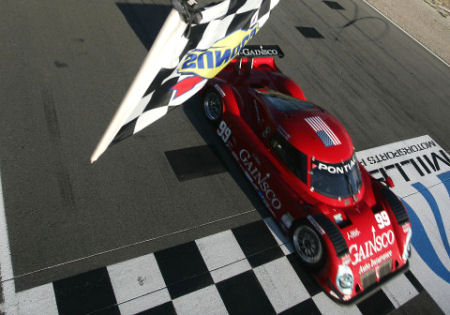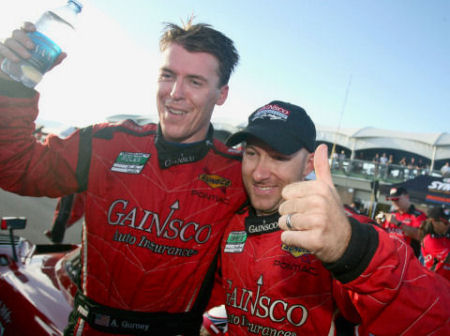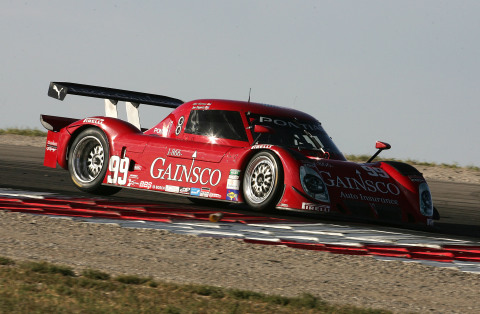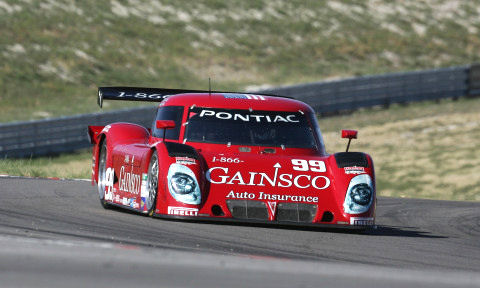The Way It Is/ Grand-Am champions Gurney & Fogarty focus on Daytona
by Gordon Kirby Alex Gurney and Jon Fogarty took their second Grand-Am championship in three years in 2009. Driving Bob Stallings's Gainsco Riley-Pontiac the California duo won four races this year and have won a total of twelve races over the past three seasons. Gurney and Fogarty battled this year against defending champions Scott Pruett and Memo Rojas in Chip Ganassi's Riley-Lexus and a fleet of others including Wayne Taylor's Dallara-Ford with Max Angelelli and Brian Frisselle driving, Penske's Riley-Porsche with factory Porsche drivers Timo Bernhard and Romain Dumas and the Brumos Riley-Porsches led by David Donohue.
Alex Gurney and Jon Fogarty took their second Grand-Am championship in three years in 2009. Driving Bob Stallings's Gainsco Riley-Pontiac the California duo won four races this year and have won a total of twelve races over the past three seasons. Gurney and Fogarty battled this year against defending champions Scott Pruett and Memo Rojas in Chip Ganassi's Riley-Lexus and a fleet of others including Wayne Taylor's Dallara-Ford with Max Angelelli and Brian Frisselle driving, Penske's Riley-Porsche with factory Porsche drivers Timo Bernhard and Romain Dumas and the Brumos Riley-Porsches led by David Donohue.
"It was the usual great racing and a lot of fun for me as a driver," Gurney grins. "It seemed like every race we line up for we can expect a real epic battle. It's good racing and I hope it continues."
Gurney and Fogarty are old racing buddies. They fought for the Atlantic championship back in 2002 with Fogarty winning and Gurney winding up third in points. Fogarty won the Atlantic title again two years later but both were frustrated in their attempts to break into the failing Champ Car series and settled in as teammates in 2006 at Bob Stallings's Gainsco Grand-Am team.
Today, Gurney and Fogarty are in their mid-thirties, both happily married with young families. Alex lives in Newport Beach with his wife Colleen and two daughters, a three-year old and a three-month old baby. Fogarty and his wife Sara live in Bend, Oregon with a three and half year old son and fourteen month old daughter.

© LAT USA
Fogarty says their dominant win from the pole at Miller Motorsports Park outside Salt Lake City in September was the key to winning this year's Grand-Am title. Fogarty took his fourth pole in a row at MMP and Gurney brought the car home for their fourth win of the year.
"Our on-track performance and all around performance at Salt Lake was pretty monumental," Fogarty remarks. "We knew Homestead was not going to be a very strong track for us because it's everything but a handling track. It's point and squirt, like a drag strip, but Salt Lake is pretty much the polar opposite. It's all about handling. You spend by far the majority of the lap cornering and braking. We were able to make the most of that and come out of there with the win and the points lead. That was the cushion we needed going into Homestead."
They wrapped-up the championship with a fourth-place finish at Homestead, beating Pruett and Rojas to the title by six points with Angelelli/Frisselle another six points behind.
"I can't say enough about both Jon and Alex," team owner Stallings says. "They're probably the most underappreciated race car drivers on the planet. They're really good at what they do. They stay out of trouble, they're fast when they need to be and they can nurse a car home when they have to. On more than one occasion we didn't have the same car at the end of the race that we started with and having a driver who knows how to limp that car to the finish is extremely important."
A racer himself, Stallings won the 2004 SCCA Formula Atlantic title and raced in the Grand-Am series with Gurney during his team's debut season in 2005. Gurney says this year the team wasn't confident in its ability to win the championship because it lacked performance.
"We started off the year at Daytona not very strong," Alex relates. "At that point in the year we thought a championship was going to be a really tall order. But things gradually improved. We got a little bit of help from the series on the engine, but not enough, and we made some really big strides with the car.

© LAT USA
Fogarty agrees that the team's June test at Mid-Ohio was essential to winning the championship.
"We started the season with a familiar package technically," Fogarty says. "We also had the addition of Chuck Houghton to our engineering group and we were able to push forward on some projects that we had been wanting to get to but hadn't had the time or personnel to do. That all came to fruition at a post-event test at Mid-Ohio. We were able to test some of the things that had been on the drawing board and they proved to be viable. That stepped-up the chassis program quite a bit and we were able to move the pace of the car up a little bit."
Gurney believes there's still room for improvement and he's hopeful that the switch from Pontiac to Chevrolet engine branding will also help the team's cause.
"I thought we made a big jump mid-year after Mid-Ohio and I think that will transfer over into the first half of the season next year," Alex observes. "I don't think we really maximized what we had last year so that will be interesting. We hope the new relationship with Chevrolet will prove to be a good thing. Most of the engine will be the same. There will be a couple of different things on it but hopefully Chevrolet will be fully behind it because we need all the help we can there. Otherwise, it's just building on everything we've learned."
Gurney says it took a little time to figure out how to get the best from the Grand-Am's Pirelli spec tire which replaced a Hoosier spec tire in 2008.
"There's a smaller sweet spot for the setup than with the previous tire," Gurney says. "Each track really demands a really different setup whereas that wasn't the case with the Hoosiers where we could show up to most tracks with a very similar setup. It took us a year and a little more on these tires to really hone it at each track, and that also started paying off at the end of the season."

© LAT USA
"You get comfortable as a starter dealing with starts and the opening half of the race," Fogarty says. "And Alex has gotten comfortable with finishing. It's a formula that's proven and it works, so we don't feel any reason to mess with that. There's a perception that the finishing driver is the stronger driver and I think a lot of teams will alternate, or try to share the finishing duties, in an effort not to upset or to appease egos among drivers.
"But one of the strong suits about our team is the egos are not there. Our goal is to win and I'm confident in my ability to finish, if needs be. I think I've proved that at Laguna Seca this year. We just want to win and we have a winning formula that works so we stick by it.
"We've really honed our driver change procedure to go from me to Alex," Fogarty adds. "There's enough of a differential in our heights that I have to use a seat insert. So when I get out of the car the seat insert comes out with me as Alex goes in. It's easier to yank the seat insert out than to put it in and the belts are already loose and adjusted for Alex because there's now a void that needs to be filled. So we found a rhythm and a quick one with the driver changes from me to Alex."
Stallings says both the drivers and team have learned a lot over the last four years.
"When we first had Jon and Alex, I think we had an extremely well-engineered car and we had two drivers who were very fast," Stallings observes. "But we weren't as good as we needed to be in staying out of trouble on the track and making sure the car was in good shape for the last twenty minutes, which is usually when these races are decided. Even though we were fast in 2006, we didn't have a crew that had the experience of being able to deal with a lot of surprises that are always thrown your way in these races."
Stallings says it's been equally essential to motivate the entire team to equal Gurney and Fogarty's level of performance.
"The real key for us is executing a philosophy that says we need to have the best possible person occupying every position on the team," Stallings remarks. "Whether it's the guy who's sticking the gas hose in the car or holding the fire extinguisher, or changing tires, or reacting to a problem during the race. Every single person has to be better than the person occupying those positions on all the competing teams.

© LAT USA
Stallings adds that stability within his small, fourteen-man team is another key element in the operation's success.
"The really lucky thing for us is that we've had great continuity on this team. That is so helpful because these guys almost don't even have to communicate with words. They can simply glance at each other and know how they're supposed to respond to either a problem or an opportunity."
In true NASCAR style, the Grand-Am controls play with car and engine equalization rules and unpredictable full-course yellows. Drivers and teams can't allow themselves to get upset about these things.
"It took a little while to really understand the strategy and how the races unfold," Gurney says. "Trying to take advantage of the yellows is a key thing. There are just a lot of little things that add up that we've learned over the years and finally understood. I would say we go into each race with a really good gameplan and we've learned how to execute and how to react."
Fogarty expands on dealing with sometimes seemingly arbitrary yellows and the overall nature of the Grand-Am's NASCAR-like system.
"You try to control the things that are within your control and yellows are absolutely not in your control," Fogarty remarks. "It's tough with a lot of the rules they have, like the thirty-minute rule and mandatory stops and what always seems like a yellow just before or immediately after a window opens-up. It can be frustrating but there's nothing you can do about it. We run our strategy as if those things are just part of the program. It's just the reality. We just try to do everything as best we can and ignore that stuff.
"There's no doubt that the frustration and anger level rises when it seems like things are stacked against us and our luck is bad. But Bob (Stallings) is a pretty good keeper of the peace. He keeps you on an even keel when those things come along. Kyle (Brannan), our engineer, can go off his rocker, but even though he's upset he's always able to maintain his composure relative to communications with the driver sitting in the car. His frustration isn't communicated across the radio."
Team owner Stallings says his company is doing well in today's tough economic environment and has done a fine job of using the race team as a promotional platform.
"There's no question that we're going through really difficult times," Stallings says. "I must say I've been pretty doomy and gloomy about the economy for almost three years now. I've been hoping I'd be wrong about my predictions, but I'm afraid I haven't. Things are really tough out there. But Gainsco will make money this year and most people in our business will not. I think we'll have a profitable year in 2010 as well. There are a lot of people who are jockeying for the affections of independent insurance agents.
"Having this car is, without doubt, a very significant advantage for Gainsco. The marketing people and the management group at Gainsco have done a really wonderful job of activating the sponsorship and getting everything they can out of our assocation with the race team."
Gurney and Fogarty count themselves lucky to be with such a committed team owner and sponsor.
"It's brutal out there right now as we all know," Fogarty remarks. "In a certain sense, the program is able to sustain itself through these tough times because it's an extremely lean program. There's very little fat on it anywhere so it operates efficiently as a race operation. And what Gainsco has done with the sponsorship and the way they've utililzed it to its full potential is really impressive. It's nice as a driver to have a sponsor that's really involved. It's great. I feel very fortunate to be a part of it. Everybody is really committed and passionate and out there to win. So, it's cool.
"We're losing some support from General Motors but we'll make do," Fogarty adds. "Most everyone is figuring out ways to make sacrifices to make it work. We're going to limit our testing. We didn't go to Daytona last week for example, but I don't think it's going to be an impairment as far as our performance on the track."
The team confirmed two weeks ago that four-time NASCAR champion Jimmie Johnson and 1996 CART champion Jimmy Vasser will again co-drive with Gurney and Fogarty in the Rolex 24 hours at Daytona at the end of January. Team owner Stallings is delighted to have Johnson and Vasser among his drivers for that race and hopes the team can pull off its first Daytona victory.
"Obviously, winning the championship is very satisfying," Stallings says. "Everyone involved did a tremendous job, but now we're focused on the Rolex 24. We've never had an opportunity to win that race. We got close in 2008 and we're ready to try again. We've got four guys that have some experience with each other and know how the whole thing works. That gives you an edge. Both Jimmie and Jimmy are always very quick in the car and very careful of taking care of the car while they're out there. Of course, Alex and Jon are old hands now and we have great confidence in them. So I'm really excited about the 24 hour race and very hopeful for the 2010 season."
Stallings maintains an ongoing email relationship with NASCAR champ Johnson.
"Jimmie is a fascinating guy," Stallings remarks. "If Jimmie were running full-time in our series he would be butting heads with Alex to be the fastest driver out there. He's really a talented driver. I remember the first time we put Jimmie in the car it was raining and I was scared to death because I didn't know if a Cup driver could drive in the rain. And he was awesome in the rain, just really outstanding.
"Jimmie feels like he's part of our team. Jimmie and I communicate by text messages throughout the season. He'll text me a message right before and right after our races and I usually do the same with him. He's fascinated by our kind of racing. He likes driving in the 'Red Dragon' and he feels that when he gets in our car he has a chance to win."
Gurney couldn't be happier to have Johnson and Vasser back for Daytona.
"It's definitely a good thing," Gurney says. "There are no unknowns and I think that makes a big difference for that race. We don't have to worry about how these guys fit in the car or how the rotation and driver changes work. It makes it a lot easier and we'll all be less high-strung."
Fogarty agrees: "Having Jimmie and Jimmy back, the same old crew, is great. They're both super-capable and they both want to win it really badly. We talked over whether we were going to run just three guys with Jimmie and Alex and I. But running four drivers has its advantages, for sure."
Fogarty, Gurney and Johnson agreed Vasser was the only man for the job.
"We had a roundtable discussion of who that guy was going to be and Jimmy is plug in and play," Fogarty comments. "He's smart and he's fast. He just gets in and gets the job done with no BS. And that's pretty important, especially as there's such limited running during that event prior to the race. A guy like that is good to have."
Stallings was delighted that his drivers voted to bring Vasser back for the fifth year in a row as part of their Daytona driving team.
"I love Jimmy Vasser," Stallings grins. "At night, when it's one or two o'clock in the morning and Jimmy's in the car he wakes me right up because he's very fast. He's a terrific racer. He really knows how to stay out of trouble and how to get a pass done without tearing the car up. He also knows when to let guys go by him. He's just got a lot of maturity."
Fogarty says horsepower is equally important as reliability in winning at Daytona.
"The formula of course, is to be reliable, stay out of trouble and have a competitive power plant because Daytona is definitely a horsepower track," Fogarty relates. "The team is going through the car with a fine tooth comb, like they always do, to try to anticipate any potential problem areas and come up with solutions. We'll try to leave nothing to chance and we'll find out in early January how we are power-wise.
"You don't worry so much about the horsepower for the 24 hours. It's more an indication of what potentially the rest of the year may hold. But last year showed you need the power when three or four cars are still on the lead lap and you need to pass. It's so tough. You need everything going for you to win that race."
Gurney is optimistic about the team's chances at Daytona in 2010.
"Obviously, it's a really big challenge," Alex remarks. "Ganassi has won that race a lot of times and we've learned a lot from watching those guys. I think that race tests how good your team is more than any other. There are so many things involved and you've got to be on top of everything.
"I think reliability is number one. Usually, people have some problem at some point in the race, and just knowing the things that break on the car and having disciplined drivers that stay out of trouble, all those things are going to make a difference. I think we're in a position where we're ready to win it. I think we've got all our ducks in a row."
The Grand-Am has lost the Penske team but the rest of the series lineup appears to be intact. Gurney hopes for a good field and plenty of competition at Daytona.
"I hope it's a strong field," Alex adds. "We'll see. I think for all racing across the board from top to bottom it's been a tough year, and it will be tough again in 2010. So I'd love to see a nice field at Daytona."
The Gainsco team didn't participate in last week's Rolex 24 hours test at Daytona but will run the next test session on January 8-10. Come the race on the last weekend in January we'll find out if the optimism harbored by Gurney, Fogarty and Stallings is justified. Even as the first snow flies here in New Hampshire and everyone gets ready for Christmas, I'm looking forward to it.
*Last Wednesday I enjoyed another session on Mike Knight's radio show 'The Race Reporters', joining host Knight, Holly Cain and Jeff Burk in a roundtable season review. We covered a lot of ground, had some fun, and I think you'll enjoy it. Here's a link to the show
Auto Racing ~ Gordon Kirby
Copyright 2009 ~ All Rights Reserved
Copyright 2009 ~ All Rights Reserved
Top of Page